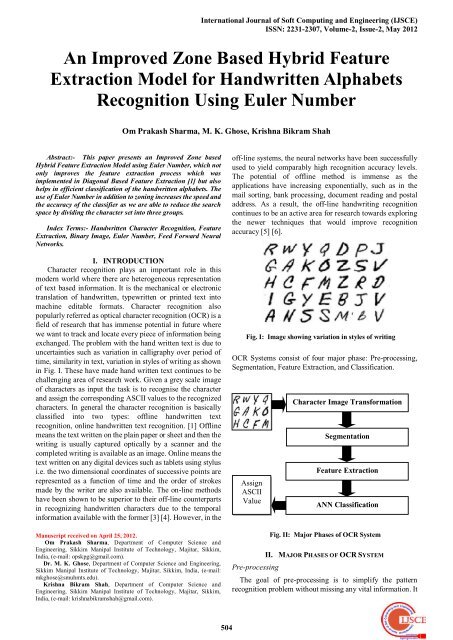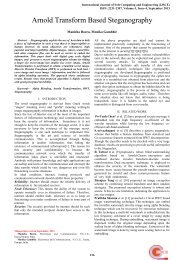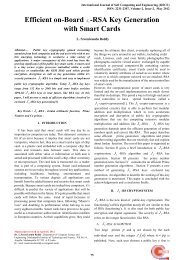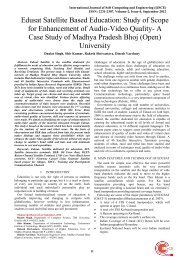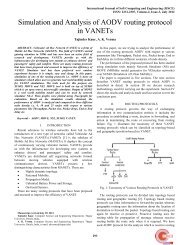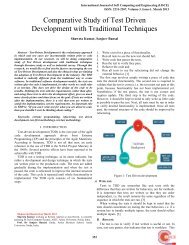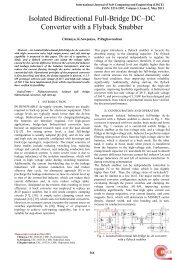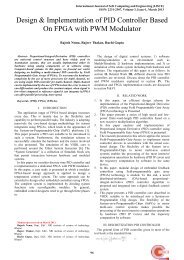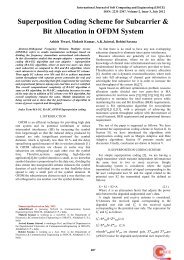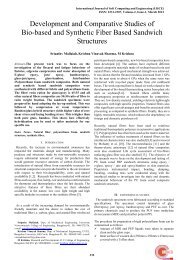An Improved Zone Based Hybrid Feature Extraction Model for ...
An Improved Zone Based Hybrid Feature Extraction Model for ...
An Improved Zone Based Hybrid Feature Extraction Model for ...
You also want an ePaper? Increase the reach of your titles
YUMPU automatically turns print PDFs into web optimized ePapers that Google loves.
International Journal of Soft Computing and Engineering (IJSCE)ISSN: 2231-2307, Volume-2, Issue-2, May 2012<strong>An</strong> <strong>Improved</strong> <strong>Zone</strong> <strong>Based</strong> <strong>Hybrid</strong> <strong>Feature</strong><strong>Extraction</strong> <strong>Model</strong> <strong>for</strong> Handwritten AlphabetsRecognition Using Euler NumberOm Prakash Sharma, M. K. Ghose, Krishna Bikram ShahAbstract:- This paper presents an <strong>Improved</strong> <strong>Zone</strong> based<strong>Hybrid</strong> <strong>Feature</strong> <strong>Extraction</strong> <strong>Model</strong> using Euler Number, which notonly improves the feature extraction process which wasimplemented in Diagonal <strong>Based</strong> <strong>Feature</strong> <strong>Extraction</strong> [1] but alsohelps in efficient classification of the handwritten alphabets. Theuse of Euler Number in addition to zoning increases the speed andthe accuracy of the classifier as we are able to reduce the searchspace by dividing the character set into three groups.Index Terms:- Handwritten Character Recognition, <strong>Feature</strong><strong>Extraction</strong>, Binary Image, Euler Number, Feed Forward NeuralNetworks.I. INTRODUCTIONCharacter recognition plays an important role in thismodern world where there are heterogeneous representationof text based in<strong>for</strong>mation. It is the mechanical or electronictranslation of handwritten, typewritten or printed text intomachine editable <strong>for</strong>mats. Character recognition alsopopularly referred as optical character recognition (OCR) is afield of research that has immense potential in future wherewe want to track and locate every piece of in<strong>for</strong>mation beingexchanged. The problem with the hand written text is due touncertainties such as variation in calligraphy over period oftime, similarity in text, variation in styles of writing as shownin Fig. I. These have made hand written text continues to bechallenging area of research work. Given a grey scale imageof characters as input the task is to recognise the characterand assign the corresponding ASCII values to the recognizedcharacters. In general the character recognition is basicallyclassified into two types: offline handwritten textrecognition, online handwritten text recognition. [1] Offlinemeans the text written on the plain paper or sheet and then thewriting is usually captured optically by a scanner and thecompleted writing is available as an image. Online means thetext written on any digital devices such as tablets using stylusi.e. the two dimensional coordinates of successive points arerepresented as a function of time and the order of strokesmade by the writer are also available. The on-line methodshave been shown to be superior to their off-line counterpartsin recognizing handwritten characters due to the temporalin<strong>for</strong>mation available with the <strong>for</strong>mer [3] [4]. However, in theManuscript received on April 25, 2012.Om Prakash Sharma, Department of Computer Science andEngineering, Sikkim Manipal Institute of Technology, Majitar, Sikkim,India, (e-mail: opskpg@gmail.com).Dr. M. K. Ghose, Department of Computer Science and Engineering,Sikkim Manipal Institute of Technology, Majitar, Sikkim, India, (e-mail:mkghose@smuhmts.edu).Krishna Bikram Shah, Department of Computer Science andEngineering, Sikkim Manipal Institute of Technology, Majitar, Sikkim,India, (e-mail: krishnabikramshah@gmail.com).off-line systems, the neural networks have been successfullyused to yield comparably high recognition accuracy levels.The potential of offline method is immense as theapplications have increasing exponentially, such as in themail sorting, bank processing, document reading and postaladdress. As a result, the off-line handwriting recognitioncontinues to be an active area <strong>for</strong> research towards exploringthe newer techniques that would improve recognitionaccuracy [5] [6].Fig. I: Image showing variation in styles of writingOCR Systems consist of four major phase: Pre-processing,Segmentation, <strong>Feature</strong> <strong>Extraction</strong>, and Classification.AssignASCIIValuePre-processingCharacter Image Trans<strong>for</strong>mationSegmentation<strong>Feature</strong> <strong>Extraction</strong>ANN ClassificationFig. II: Major Phases of OCR SystemII. MAJOR PHASES OF OCR SYSTEMThe goal of pre-processing is to simplify the patternrecognition problem without missing any vital in<strong>for</strong>mation. It504
[1].<strong>An</strong>ita Pal et al [12] have proposed the features extractionfrom Boundary tracing and their Fourier Descriptors. Also ananalysis has been carried out to determine the number ofhidden layer nodes to achieve high per<strong>for</strong>mance of backpropagation network. A recognition accuracy of 94% hasbeen reported <strong>for</strong> handwritten English characters with lesstraining time.E. Srinivasan et al [1] have proposed diagonal basedfeature extraction <strong>for</strong> handwritten alphabets recognitionsystem using neural network and from the test results it hasbeen identified that the diagonal method of feature extractionyields the highest recognition accuracy of 97.8 % <strong>for</strong> 54features and 98.5% <strong>for</strong> 69 features.ZoningZoning is one of the feature most popular and simple toimplement feature extraction method. The commercial OCRsystem developed by CALERA used Zoning mechanism onbinary characters [10]. <strong>An</strong> (n*m) grid is superimposed on thecharacter image and then <strong>for</strong> each zone average value iscomputed giving a feature vector of length (n*m), if requiredfurther we can compute the average on this zone again in rowwise and column wise respectively.Fig. III: Zoning of Characters [5]Euler NumberEuler Number is defined as number of connected componentsin the image minus the number of holes. This will divide thecharacters into 3 groups [2]: Euler number equal one and this contains: s, S, f, F, G, h,H, j, J, k, K, l, L, z, Z, x, X, c, C, v, V, n, N, m, M, w, W, E, r,t, T, y, Y, u, U, i, I. Euler number equal zero and this contains: q, Q, R, o, O, p,P, a, A, d, D, g, b. Euler number equal minus one and this contains: B.Euler Number Computation [17][18]International Journal of Soft Computing and Engineering (IJSCE)ISSN: 2231-2307, Volume-2, Issue-2, May 2012Z= the number of occurrences of the 2x2 pattern (i.e. thenumber diagonals)1 00 10 11 0Fig. IV: Binary ObjectWhen the above binary object (i.e. fig. 4.) was given as aninput to the Matlab to compute the Euler Number the resultobtained is;Number of object = 1Number of holes = 1Euler Number = 0IV. PURPOSED FEATURE EXTRACTION MODELHere, we have a new and an improved approach to featureextraction is proposed which may be efficient as compared to<strong>for</strong>mer methods. In this proposed approach first we computethe Euler Number. <strong>Based</strong> on the result of computationwhether the result is positive or negative or zero, will dividethe character set into three groups. After the categorizationwe go <strong>for</strong> Diagonal based feature <strong>Extraction</strong> method asimplemented by J. Pradeep, E. Shrinivasan and H. Himavathi[1]. In this feature extraction process, the individualsegmented characters are first resized into a size 90x60 pixeland then the Euler Number is computed <strong>for</strong> the character toidentify in which class it belongs. After the reults it is thenfollowed by the diagonal based zoning operation is carriedwhere an image is further divided into 54 equal zones, each ofsize 10x10 pixels. The features are extracted from the pixelsof each zone by moving along its 10X10 pixels.Euler Number = ¼(X – V+2Z) <strong>for</strong> 4 connectivityEuler Number = ¼(X – V –2Z) <strong>for</strong> 8 connectivityi.e. Euler number = ¼(convexities – concavities+2*diagonal)where,X = the number of occurrences of the 2x2 pattern (i.e. thenumber of convexities)0 00 10 0 1 0 0 11 0 0 0 0 0V= the number of occurrences of the 2x2 pattern (i.e. thenumber concavities)1 1 1 1 0 1 1 01 0 0 1 1 1 1 1Fig. V: Diagonal <strong>Based</strong> Zoning Operation [1]Each zone has 10 horizontal lines and the <strong>for</strong>egroundpixels present long each horizontal line is summed to get asingle sub-feature, thus 10 sub-features are obtained from theeach zone. These 10 sub-features values are averaged to <strong>for</strong>ma single feature value and placed in the corresponding zone.This procedure is sequentially repeated <strong>for</strong> all the zones.There could be some zones which are empty of <strong>for</strong>egroundpixels. The feature values corresponding to these zones arezero. Finally, 54 features are extracted <strong>for</strong> each character. In506
<strong>An</strong> <strong>Improved</strong> <strong>Zone</strong> <strong>Based</strong> <strong>Hybrid</strong> <strong>Feature</strong> <strong>Extraction</strong> <strong>Model</strong> <strong>for</strong> Handwritten Alphabets Recognition Using EulerNumberaddition, 9 and 6 features are obtained by averaging thevalues placed in zones row-wise and column-wise,respectively. As result, every character is represented by 69,that is, 54 +15 features [1, 11]. These extracted features areused to train a feed <strong>for</strong>ward back propagation neural network<strong>for</strong> per<strong>for</strong>ming classification and recognition tasks.V. CLASSIFICATIONA feed <strong>for</strong>ward back propagation neural network havingtwo hidden layers with architecture of 69-100-100-26 is usedto per<strong>for</strong>m the classification. The hidden layers use logsigmoid activation function, and the output layer is acompetitive layer, as one of the characters is to be identified.The feature vector is denoted as p where p = (x1,x2,x3,.......xd)where x denotes features and d is the number of zones intowhich each character is divided. The number of input neuronsis determined by length of the feature vector d. The totalnumbers of characters t determines the number of neurons inthe output layer [6]. MLPs has to be so designed or framedthat the recognition system should be 50% faster than theindividual MLPs, while retaining the recognition rate at itshighest value.The network training parameters are:Input nodes: 69Hidden nodes: 100 eachOutput nodes: 26 (alphabets)Training Algorithm: Gradient Descent with MomentumTraining and Adaptive LearningPer<strong>for</strong>m function: Mean Square ErrorTraining Goal Achieved: 0.000001Training Epochs: 100000Training Momentum Constant: 0.9Training Learning Rate: 0.01VI. RESULT AND DISCUSSIONRecognition system has been implemented using Matlab7.5. The scanned image and the image drawn using paintapplication is given as an input to the feed <strong>for</strong>ward neural netarchitecture where it is first converted from .png to .tiff fileand then it is resized to a standard <strong>for</strong>mat of 60*90 pixelsimage followed by the thresholding/binarization operationwhich uses ‗otsu‘ algorithm to scaled it into 0 and 1 binaryimage.The structure of neural network includes an input layerwith 69 inputs including row wise and column wise features,two hidden layers each with 100 neurons and an output layerwith 26 neurons. The gradient descent back propagationmethod with momentum and adaptive learning rate andlog-sigmoid transfer functions is used <strong>for</strong> neural networktraining [1]. Neural network has been trained using knowndataset. A recognition system using two different features,one simple diagonal based feature and the other includes theEuler number. In both the cases size of feature vectors issame; the results obtained using these two different types offeature extraction are summarized in Table I & II.Table I. Recognition result/time elapsed obtained basedon diagonal based feature extractionAlphabetsDiagonal <strong>Based</strong> ResultA Recognised 0.4935B Recognised 0.7075D Recognised 0.6037E Recognised 0.6055P Recognised 1.4506Q Recognised 0.1766M Recognised 0.6070S Recognised 1.9696T Recognised 0.1781Y Recognised 1.9688Z Recognised 0.5088Elapsed Time (inseconds)Table II. Recognition result/time elapsed obtained basedon hybrid based feature extractionAlphabets <strong>Hybrid</strong> <strong>Based</strong> Result Elapsed Time (inseconds)A Recognised 0.4207B Recognised 0.1953D Recognised 0.5103E Recoginsed 0.1941P Recognised 0.2986Q Recognised 0.1941M Recognised 1.0355S Recognised 0.4055T Recognised 0.5103Y Recognised 0.1941Z Recognised 0.1721VII. CONCLUSIONA new type of feature extraction, namely, an efficientfeature extraction method is proposed which can give highrecognition accuracy while requiring less time <strong>for</strong> trainingand classification both as compare to the diagonal basedfeature extraction method which gives upto 98.5% accuracyrequiring less time <strong>for</strong> training [1]. The per<strong>for</strong>mance of thenetwork has been simulated using Matlab 7.5. To simplify theproject it has been restricted to few character sets. The507
constraints are posed to clear the concept behind new model.It can be said that the model is not a complete mechanism tocharacter recognition. The system per<strong>for</strong>ms very well duringclassification <strong>for</strong> these limited set of characters. It not onlyyields higher levels of recognition accuracy but the overalltime efficiency has increased as compared to the systemsemploying the diagonal based feature extraction [1] or anyother conventional methods of feature extraction.So, using the Euler Number computation which is good incategorizing the alphabets into different groups with zonebased feature extraction method will be effective processincreasing the accuracy and speed.International Journal of Soft Computing and Engineering (IJSCE)ISSN: 2231-2307, Volume-2, Issue-2, May 2012[16] N. Sharma, U. Pal, F. Kimura, "Recognition of Handwritten KannadaNumerals", 9th International Conference on In<strong>for</strong>mation Technology(ICIT'06), ICIT, pp. 133-136.[17] Ciar´ an ´ O Conaire, ―Efficient Euler-Number Thresholding‖, Centre<strong>for</strong> Digital Video Processing, Dublin City University, Ireland.[18] M Arijit Bishnu, Bhargab B. Bhattacharya, Malay K. Kundu b C.A.Murthy, Tinku Acharya, ―A pipeline architecture <strong>for</strong> computing theEuler number of a binary image‖, Journal of Systems Architecture 51(2005) 470–487.REFERENCES[1] J Pradeep, E Shrinivasan and S.Himavathi, ―Diagonal <strong>Based</strong> <strong>Feature</strong><strong>Extraction</strong> <strong>for</strong> Handwritten Alphabets Recognition System UsingNeural Network‖, International Journal of Computer Science &In<strong>for</strong>mation Technology (IJCSIT), vol . 3, No 1, Feb 2011.[2] M. Alata — M. Al-Shabi, ― Text Detection <strong>An</strong>d Character RecognitionUsing Fuzzy Image Processing‖, Journal of Electrical Engineering,vol. 57, no. 5, 2006, 258–267[3] R. Plamondon and S. N. Srihari, ―On-line and off- line handwrittencharacter recognition: A comprehensive survey,‖IEEE. Transactionson Pattern <strong>An</strong>alysis and Machine Intelligence, vol. 22, no. 1, pp. 63-84,2000.[4] N. Arica and F. Yarman-Vural, ―<strong>An</strong> Overview of CharacterRecognition Focused on Off-line Handwriting‖, IEEE Transactions onSystems, Man, and Cybernetics, Part C: Applications and Reviews,2001, 31(2), pp. 216 - 233.[5] U. Bhattacharya, and B. B. Chaudhuri, ―Handwritten numeraldatabases of Indian scripts and multistage recognition of mixednumerals,‖ IEEE Transaction on Pattern analysis and machineintelligence, vol.31, No.3, pp.444-457, 2009.[6] U. Pal, T. Wakabayashi and F. Kimura, ―Handwritten numeralrecognition of six popular scripts,‖ Ninth International conference onDocument <strong>An</strong>alysis and Recognition ICDAR 07, Vol.2, pp.749-753,2007.[7] Devinder Singh and Baljit Singh Khehra, ―Digit Recognition SystemUsing Back Propagation Neural Network‖, International Journal ofComputer Science and Communication Vol. 2, No. 1, January-June2011, pp. 197-205[8] VENTZAS, DIMITRIOS 1, NTOGAS, NIKOLAOS , ―ABINARIZATION ALGORITHM FOR HISTORICALMANUSCRIPTS‖, 12th WSEAS International conference onCommunications, Heraklion, Greece, July 23-25, 2008.[9] Bindu Philip, R. D. Sudhaker Samuel and C. R. Venugopal, Member,IACSIT, ―A Novel Segmentation Technique <strong>for</strong> Printed MalayalamCharacters‖, International Journal of Computer and ElectricalEngineering, Vol. 2, No. 4, August, 2010 1793-8163 PrintedMalayalam Characters.[10] <strong>An</strong>il Kumar Jain and Torfinn Taxt, ―<strong>Feature</strong> extraction Methods <strong>for</strong>Character Recognition- A Survey‖, Pattern Recognition, Vol.29, No.4,pp. 641-662, 1996.[11] S.V. Rajashekararadhya, and P.VanajaRanjan, ―Efficient zone basedfeature extraction algorithm <strong>for</strong> handwritten numeral recognition offour popular south-Indian scripts,‖ Journal of Theoretical and AppliedIn<strong>for</strong>mation Technology, JATIT vol.4, no.12, pp.1171-1181, 2008.[12] <strong>An</strong>ita Pal & Dayashankar Singh, ― Handwritten English CharacterRecognition Using Neural Network‖, International Journal ofComputer Science & Communication‖, Vol. 1, No.2, July-December2010, pp. 141-144[13] G. Vamvakas, B. Gatos, I. Pratikakis, N. Stamatopoulos, A. Roniotis,S.J. Perantonis, "<strong>Hybrid</strong> Off-Line OCR <strong>for</strong> Isolated Handwritten GreekCharacters", The Fourth IASTED International Conference on SignalProcessing, Pattern Recognition and Applications (SPPRA‘07), pp.197-202, Innsbruck, Austria, February 2007.[14] G. Vamvakas, B. Gatos, S. Petridis and N. Stamatopoulos, ''<strong>An</strong>Efficient <strong>Feature</strong> <strong>Extraction</strong> and Dimensionality Reduction Scheme <strong>for</strong>Isolated Greek Handwritten Character Recognition'', Proceedings ofthe 9th International Conference on Document <strong>An</strong>alysis andRecognition, Curitiba, Brazil, 2007, pp. 1073-1077.[15] Dinesh Acharya U, N V Subba Reddy and Krishnamurthy, ―Isolatedhandwritten Kannada numeral recognition using structural feature andK-means cluster,‖ IISN-2007, pp-125 -129.508


